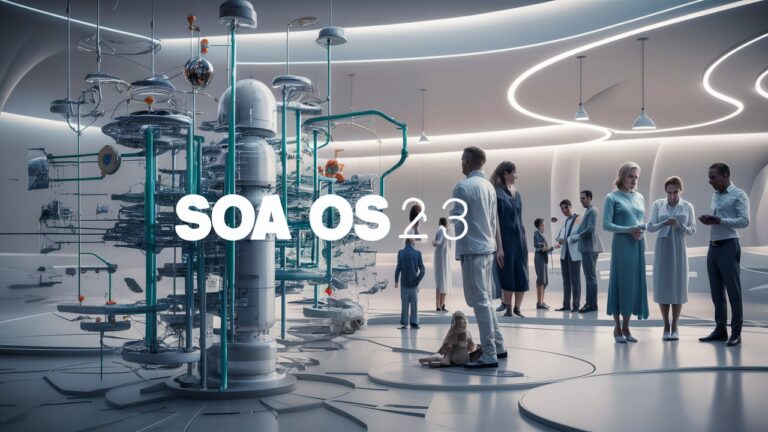Introduction
In the ever-evolving landscape of digital architecture, a new paradigm known as SOA OS23 is quietly gaining traction as a modern reimagining of classical Service-Oriented Architecture (SOA). Far from being a simple software platform, SOA OS23 represents a conceptual stack combining modular orchestration, event-first logic, semantic interoperability, and embedded ethics—designed explicitly for the complexity of AI-integrated, decentralized, and human-centric systems. As organizations move from monolithic structures to adaptive, context-aware networks of services, understanding SOA OS23 has never been more essential. In this article, we’ll explore what SOA OS23 actually is, how it diverges from traditional architectures, why it matters today, and how it’s already shaping sectors like healthcare, smart cities, and education.
What Is SOA OS23 and How Does It Differ from Traditional SOA?
At its core, SOA OS23 is not a tangible product or an operating system in the conventional sense, but a conceptual architecture framework crafted for the demands of modern digital ecosystems Cordless.iogreenecodream.com. Traditional Service-Oriented Architecture, emerging in the early 2000s, emphasized modularity and reusability but quickly became hampered by bloated service registries and rigid protocols. SOA OS23 revitalizes those core ideals with a dynamic, event-driven, AI-ready design that treats services not just as endpoints but as intelligent, aware actors within an ethical and policy-infused orchestration mesh Cordless.io.
Key Principles That Define SOA OS23
SOA OS23 is characterized by several foundational principles:
-
Event-First Logic – Instead of request-response flows, SOA OS23 is structured around ambient event streams—sensor data, user context, system triggers—creating a more responsive and real-time foundation Cordless.io.
-
Context-Aware Service Mesh – Services are routed not purely by protocol but by semantics: user intent, regional compliance, device state, and more, are all considered in real time Cordless.io.
-
Human-in-the-Loop Interfaces – Unlike systems that operate independently of human oversight, SOA OS23 integrates real-time human validation or redirection, especially vital in domains with high stakes or regulatory oversight Cordless.io.
-
Semantic Interoperability – Services communicate through shared meaning, not just matching data structures: AI mediation layers can translate between schemas, languages, and taxonomies Cordless.io.
-
Modular Compliance & Ethics Engines – Every service carries metadata around its data handling, privacy, and ethical boundaries, enabling transparent governance and automatic policy enforcement Cordless.io.
Why SOA OS23 Matters Now
Several critical trends explain why SOA OS23 is emerging as a pivotal architecture:
-
Complexity Overload – Digital systems now span cloud, edge, IoT, AI, and legacy environments—a complexity traditional architectures struggle to manage. SOA OS23 provides fluid orchestration across these elements Cordless.io.
-
AI-First Demands – Intelligent systems require adaptable orchestration, explainability, and collaboration across human and machine actors—key strengths of SOA OS23 Cordless.io.
-
Privacy & Regulation – Growing legislation like GDPR and the AI Act demand policy-aware systems. SOA OS23 embeds governance into its core, not as an afterthought Cordless.io.
-
Ethical Development – The tech community increasingly expects systems to be fair, accountable, and transparent. SOA OS23’s design philosophy reflects this shift Cordless.io.
Use Cases: SOA OS23 in Action
-
Healthcare – In a hospital setting, patient data from wearables is contextualized, passed through compliance checks, interpreted by AI, and presented to clinicians with human-in-the-loop approval—every step governed and auditable.
-
Smart Cities – Traffic sensors, emergency services, and environmental systems collaborate through event-driven orchestration. Traffic rerouting, public safety adjustments, and environmental alerts all flow within a policy-enforced mesh.
-
Education – Adaptive learning platforms that integrate real-time student feedback, learning analytics, and privacy settings, adjusting content delivery based on both AI recommendations and instructor supervision.
Conclusion
SOA OS23 is far more than a technical buzzword—it marks a shift toward adaptive, ethical, and human-aware digital architecture. By advancing the original missions of SOA with semantic awareness, embedded governance, and real-time orchestration, it offers a blueprint for systems that are resilient, transparent, and aligned with human values. As digital infrastructure grows ever more complex and regulated, SOA OS23 stands out as a timely and thoughtful response, inviting us to build systems that are not just efficient, but conscious.
FAQ (Frequently Asked Questions)
Q1: What does “SOA OS23” stand for?
It refers to a conceptual framework or “operating stack” built upon Service-Oriented Architecture principles, updated for 2023 and beyond with AI, context awareness, ethics, and policy integration Cordless.iogreenecodream.com.
Q2: How is SOA OS23 different from microservices or classic SOA?
While classic SOA focused on interoperability through defined interfaces and microservices emphasized autonomy, SOA OS23 brings context, ethics, and real-time orchestration—treating services as intelligent actors—and embeds human-in-the-loop and semantic layers Cordless.io.
Q3: Why is SOA OS23 emerging now?
Due to the rise of distributed systems, AI integration, stricter compliance needs, and ethical demands, a more adaptive, transparent, and human-aware architectural pattern is increasingly necessary Cordless.io.
Q4: Is SOA OS23 a product I can buy or install?
No. It isn’t a software or platform but a design paradigm—a set of architectural principles rather than a commercial offering Cordless.io.
Q5: What are the benefits of designing systems with SOA OS23 in mind?
Key advantages include context-aware decision making, built-in governance and ethics, resilience across cloud-edge ecosystems, and enhanced explainability and compliance in AI and real-time systems Cordless.io.
